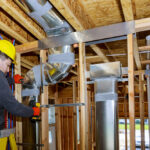When it comes to the functions of your HVAC system, perhaps the most under-discussed component involved is your ductwork setup. Responsible for transporting air throughout the home and ensuring each room is at the appropriate temperature and air quality level, your air ducts play a major role in everything your HVAC system does throughout the year — and which materials are used in your ducts may impact how they perform.
At Action Plumbing, Heating, Air & Electric, we’re proud to offer numerous HVAC services, ranging from standard solutions like AC and furnace maintenance through assistance with your duct system if needed. We’re also here to help educate our clients on the various types of HVAC duct material that might be used in their home, plus some of the designations these materials fall under. Here’s a general primer on everything you need to know.
Flexible Vs Rigid Ductwork
Basically all forms of HVAC ducts fall into two categories: Flexible or rigid. Here are some basics on each:
- Rigid ducts: The more common option found in homes today is rigid ductwork, which comes in either metal or reinforced fiberglass. Rigid ducts can be shaped into specific configurations to fit nearly any area you need, and this ability to curve the air channel makes them easier to install than flexible ducts. Rigid ducts can easily be fabricated for custom installations, and comes in a variety of sizes. It’s smooth on the inside and outside, ensuring easy cleaning and very difficult circumstances for mold or mildew to form.
- Flexible ductwork: Flexible air ducts are made of wire coils with a covering typically comprised of plastic. It’s mostly used in smaller HVAC systems when a home has been well-insulated and no longer needs the ductwork to be as rigid. It’s also used in all kinds of commercial applications, like warehouses or clean rooms that demand completely flexible air channels. Because it can bend and twist, it’s perfect for many tighter areas. This is the type of ductwork that might be found in older homes or when retrofitting an older home with HVAC.
Rectangular Vs Round Ducts
Another important designation to think about: Whether your ducts are rectangular or round in shape. The former was the only option for several decades, but round configurations have become more popular in recent years. Both have their own set of pros and cons:
- Rectangular ducts: These are sturdy, durable options that are ideal for low-pressure HVAC systems and tend to be the more commonly used option.
- Round ducts: Seen most often in high-pressure systems, these are also good for commercial applications where airflow might need to be cycled back and forth quickly (like in warehouses). They tend to do a better job of redistributing air evenly throughout the home, but they’re harder to clean.
Now that we’ve been over some of the most important air duct configuration templates, our next few sections will go over the most common materials used to create these ducts.
Fiberboard
Referring to a material that’s made of fiberglass strands bonded together with a strong resin, fiberboard is the most common type of duct material used in homes today. Fiberboard is fireproof, inexpensive and easy to cut — plus it works extremely well at preventing air leakage. It’s also one of the best materials for sound absorption, which can be helpful if your HVAC system is running loudly throughout the year.
It should be noted that fiberboard ducts are typically covered by a thin plastic coating to keep them from being exposed to the elements. Fiberboard is highly resistant to mold and mildew, making it an ideal option when considering your HVAC ductwork.
Now, fiberboard isn’t without potential downsides. For instance, its inner sections are textured due to the fiberglass strands we mentioned above — this means dust and debris might stick to it more easily than other duct materials, and this could lower your efficiency if too much debris builds up (luckily, our team is here to help with duct cleaning if this happens).
Fiberglass
In other cases, fiberglass itself will be the primary material used. This is for a range of different reasons, but mainly because it’s easy to work with and widely available. Many homeowners opt for this material when they’re replacing their existing ducts or installing new ones in tight spaces.
Fiberglass has an inner coating that prevents the air moving through the channels from coming into direct contact with the fibers themselves, which could be dangerous if they came loose. Like fiberboard, it’s very resistant to mold and mildew, which makes it an ideal option for homes in warmer climates where this moisture might pose a problem.
Fiberglass ducts do require some pretty detailed cleaning, due to their fiberglass lining.
Sheet Metal
Typically made from galvanized steel or aluminum, sheet metal ducts are also highly popular in HVAC systems — and for good reason. These types of ducts are easy to work with (and thus, fairly inexpensive) and they’re great at reducing air leakage in homes. However, one major drawback is that they tend to be quite noisy when the HVAC system is running; this means these types of ducts might not be the best choice for a bedroom, but they’re ideal when it comes to living rooms or other open spaces.
One of the most common examples used is galvanized steel ductwork. Galvanized steel provides excellent airtightness, which makes it an ideal option if you’re looking for HVAC insulation that will help lower your energy bills. However, one downside is that it’s a rather expensive option, and one that might not be ideal for lower-end HVAC systems.
For more on the different kinds of HVAC air ducts that might be present in your home, or to learn about any of our plumbing or HVAC services, speak to the staff at Action Plumbing, Heating, Air & Electric today.


